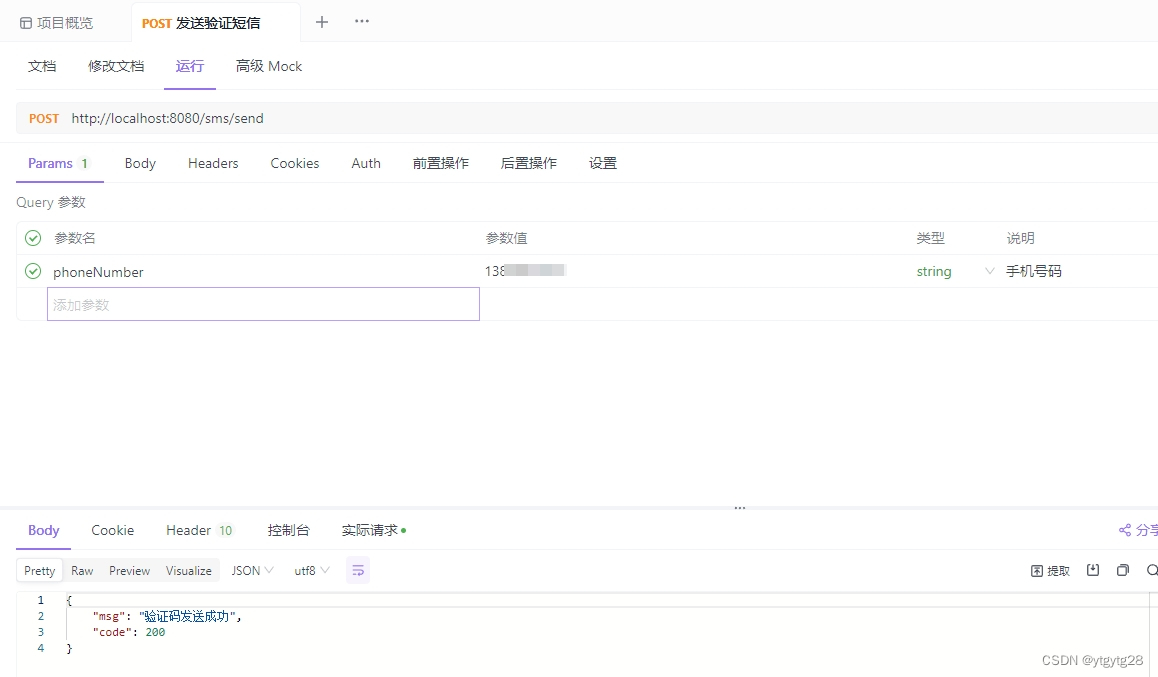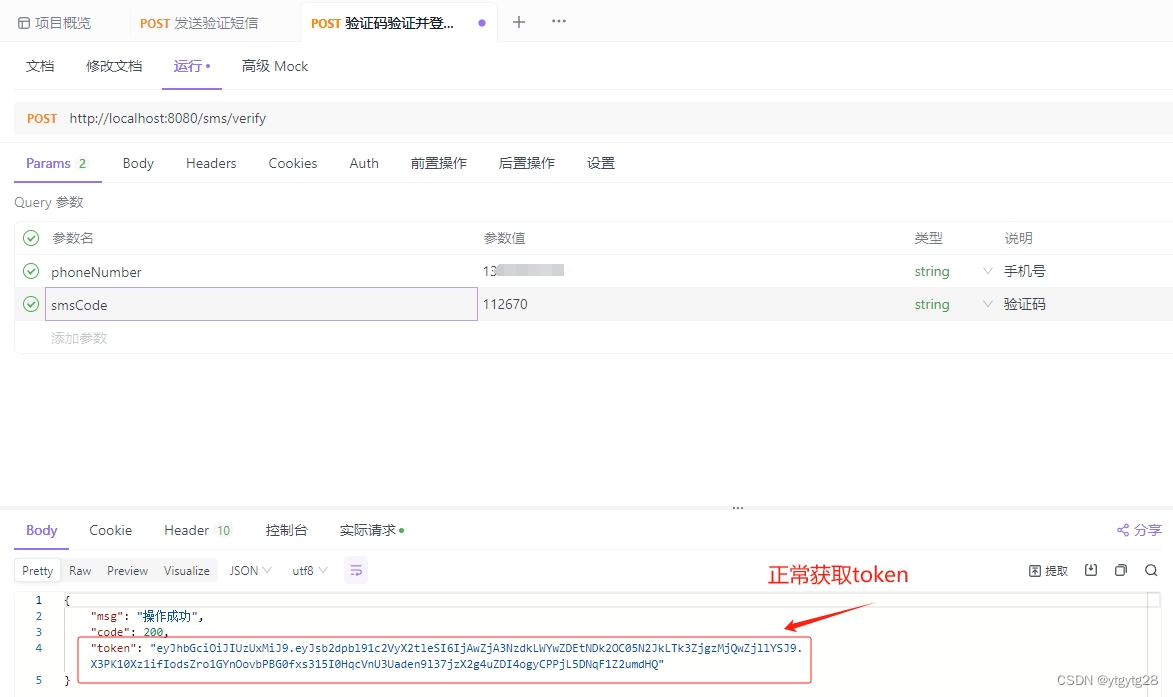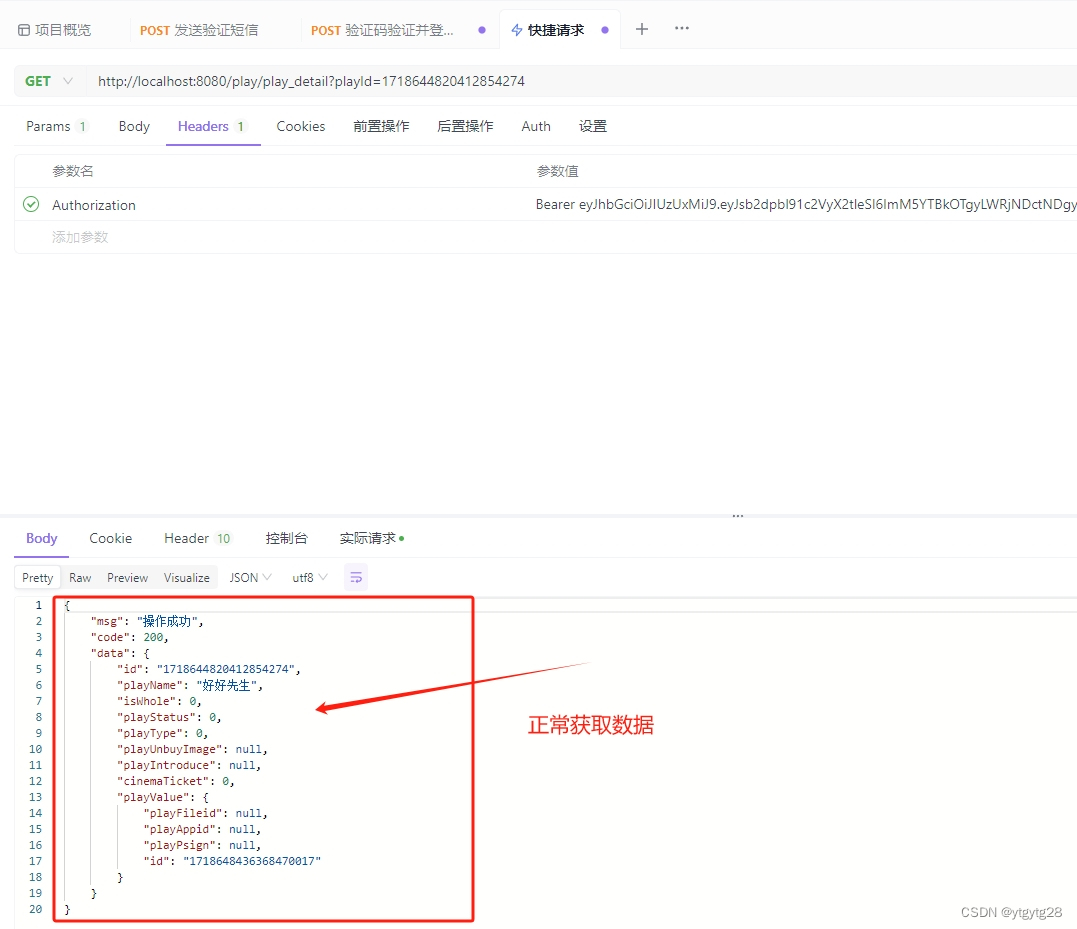热门标签
热门文章
- 1YOLOv8部署,从图像到打标签,再到标签转换,最后机器学习。_yolov8打标签程序
- 2MySQL创建表和约束条件(四)_创建数据表hzb,里面包含以下字段:bh整数字符(此项数据不能为空)并设置为主键约束,
- 3腾讯云GPU云服务器CPU是什么?主频多少?_intel xeon cooper lake 处理器,基频 3.4 ghz,睿频3.8 ghz
- 4动态规划(DP)之入门学习-数字三角形_c语言动态规划数字三角形问题dp最简单的写法
- 5利用数据可视化技术来学习钻石鉴别_diamonds.csv 百度网盘
- 6Django及Flask漏洞合集_django漏洞集合
- 7深入了解Python自然语言处理库NLTK
- 8Android音乐播放器显示startForeground(ONGOING_NOTIFICATION_ID, notification);异常解决方法_android startforeground notification
- 9基于Matlab的Q-learning算法机器人路径规划仿真_matlab qlearn
- 10Win10安装RabbitMQ_rabbitmq的注册表在哪里
当前位置: article > 正文
若依前后端分离版ruoyi-vue:增加新的登录接口(新用户表),用于小程序或者APP获取token,并使用若依的验证方法,结合腾讯云短信验证码实现手机号+验证码登陆_若依前后端分离无状态身份验证
作者:羊村懒王 | 2024-04-11 23:05:25
赞
踩
若依前后端分离无状态身份验证
1.新建—SmsController类
- package com.wanuw.user.controller.login;
-
- import com.wanuw.common.constant.Constants;
- import com.wanuw.common.core.domain.AjaxResult;
- import com.wanuw.user.service.SmsService;
- import org.springframework.beans.factory.annotation.Autowired;
- import org.springframework.web.bind.annotation.*;
-
- /**
- * 手机端验证码
- *
- * @author dagang
- */
- @RestController
- @RequestMapping("/sms")
- public class SmsController
- {
- @Autowired
- private SmsService smsService;
-
- /**
- * 生成手机验证码
- */
- @PostMapping("/send")
- public AjaxResult sendSmsCode(@RequestParam(value = "phoneNumber") String phoneNumber) {
- String message = smsService.sendSmsCode(phoneNumber);
- return AjaxResult.success(message);
- }
- /**
- * 验证手机验证码
- */
- @PostMapping("/verify")
- public AjaxResult verifySmsCode(@RequestParam(value = "phoneNumber") String phoneNumber,
- @RequestParam(value = "smsCode") String smsCode) {
- AjaxResult ajax = AjaxResult.success();
- String token = smsService.verifySmsCode(phoneNumber, smsCode);
- ajax.put(Constants.TOKEN, token);
- return ajax;
- }
- }

2.新建—SmsService类
- package com.wanuw.user.service;
-
- import com.baomidou.mybatisplus.extension.service.IService;
- import com.wanuw.common.core.domain.user.member.DbUser;
-
- /**
- * 手机端用户登录验证
- *
- * @author dagang
- */
- public interface SmsService extends IService<DbUser> {
-
- /**
- * 生成手机验证码
- */
- String sendSmsCode(String phoneNumber);
-
- /**
- * 验证手机验证码
- */
- String verifySmsCode(String phoneNumber, String smsCode);
-
- }

3.新建—SmsServiceImpl 实现层
此处注意注入的是:AppAuthenticationProvider
TokenService和RedisCache是若依框架自带
- package com.wanuw.user.service.impl;
-
- import cn.hutool.core.util.RandomUtil;
- import com.baomidou.mybatisplus.core.conditions.query.LambdaQueryWrapper;
- import com.baomidou.mybatisplus.extension.service.impl.ServiceImpl;
- import com.tencentcloudapi.sms.v20190711.models.SendStatus;
- import com.wanuw.common.config.tencent.SmsConfig;
- import com.wanuw.common.constant.CacheConstants;
- import com.wanuw.common.constant.Constants;
- import com.wanuw.common.core.domain.model.LoginUser;
- import com.wanuw.common.core.redis.RedisCache;
- import com.wanuw.common.exception.ServiceException;
- import com.wanuw.common.exception.user.CaptchaException;
- import com.wanuw.common.exception.user.CaptchaExpireException;
- import com.wanuw.common.exception.user.UserNotExistsException;
- import com.wanuw.common.exception.user.UserPasswordNotMatchException;
- import com.wanuw.common.utils.ChineseNameUtils;
- import com.wanuw.common.utils.MessageUtils;
- import com.wanuw.common.utils.SecurityUtils;
- import com.wanuw.common.utils.tencent.SmsUtil;
- import com.wanuw.framework.manager.AsyncManager;
- import com.wanuw.framework.manager.factory.AsyncFactory;
- import com.wanuw.framework.web.service.TokenService;
- import com.wanuw.common.core.domain.user.member.DbUser;
- import com.wanuw.member.mapper.DbUserMapper;
- import com.wanuw.member.service.IDbUserService;
- import com.wanuw.user.controller.login.AppAuthenticationProvider;
- import com.wanuw.user.service.SmsService;
- import org.springframework.beans.factory.annotation.Autowired;
- import org.springframework.security.authentication.BadCredentialsException;
- import org.springframework.security.authentication.UsernamePasswordAuthenticationToken;
- import org.springframework.security.core.Authentication;
- import org.springframework.stereotype.Service;
-
- import javax.annotation.Resource;
- import java.util.concurrent.TimeUnit;
-
- /**
- * 手机端用户登录验证
- *
- * @author dagang
- */
- @Service
- public class SmsServiceImpl extends ServiceImpl<DbUserMapper, DbUser> implements SmsService {
-
- @Autowired
- private TokenService tokenService;
-
- @Resource
- private AppAuthenticationProvider authenticationManager;
-
- @Resource
- private SmsConfig smsConfig;
-
- @Autowired
- private RedisCache redisCache;
-
- @Autowired
- private IDbUserService dbUserService;
- /**
- * 创建手机验证码
- */
- @Override
- public String sendSmsCode(String phoneNumber) {
- // 下发手机号码,采用e.164标准,+[国家或地区码][手机号]
- String[] phoneNumbers = {"+86" + phoneNumber};
- // 生成6位随机数字字符串
- String smsCode = RandomUtil.randomNumbers(6);
- // 模板参数:若无模板参数,则设置为空(参数1为随机验证码,参数2为有效时间)
- String[] templateParams = {smsCode, smsConfig.getExpireTime().toString()};
- // 发送短信验证码
- SendStatus[] sendStatuses = SmsUtil.sendSms(smsConfig, templateParams, phoneNumbers);
- if ("Ok".equals(sendStatuses[0].getCode())) {
- // 创建短信验证码缓存的key并设置过期时间
- String key = CacheConstants.CAPTCHA_TELPHONE_CODE_KEY + phoneNumber;
- redisCache.setCacheObject(key, smsCode, smsConfig.getExpireTime(), TimeUnit.MINUTES);
- return "验证码发送成功";
- } else {
- return "验证码发送失败:" + sendStatuses[0].getMessage();
- //return "验证码发送失败:";
- }
- }
-
- /**
- * 验证手机验证码
- */
- @Override
- public String verifySmsCode(String phoneNumber, String smsCode) {
- //1.验证码校验
- checkCode(phoneNumber, smsCode);
- //2.检查用户手机号是否已经注册,若未注册,直接注册成用户
- LambdaQueryWrapper<DbUser> queryWrapper = new LambdaQueryWrapper<>();
- queryWrapper.eq(DbUser::getUserTel, phoneNumber);
- DbUser dbUser = dbUserService.getOne(queryWrapper);
-
- if (dbUser == null) {
- //说明未注册过账户,开始注册账户
- DbUser dbUserNew = new DbUser();
- dbUserNew.setUserTel(phoneNumber);
- //添加默认密码123456
- dbUserNew.setPassword(SecurityUtils.encryptPassword("123456"));
- //这是个生成随机汉字名字的工具
- dbUserNew.setUserNickname(ChineseNameUtils.randomChineseName());
- dbUserNew.setUserName(phoneNumber);
- dbUserService.save(dbUserNew);
- }
- String username = phoneNumber;
- String password = "123456";
- //自定义用户名和密码
-
- // 用户验证
- Authentication authentication;
- try {
- // 原来其实就这么一句话:该方法会去调用UserDetailsServiceImpl.loadUserByUsername。指的是原来若依自定义的UserDetailsServiceImpl
- //此处会让人很迷惑,特别是对新手来说。其实就是调用了AppUserDetailsServiceImpl中的loadUserByUsername方法
- //而这个方法的是通过AppAuthenticationProvider中去发起的。所以这个authenticationManager 其实就是注入的AppAuthenticationProvider
- //这个地方一定要注意!!!!!
- authentication = authenticationManager
- .authenticate(new UsernamePasswordAuthenticationToken(username, password));
- } catch (Exception e) {
- if (e instanceof BadCredentialsException) {
- AsyncManager.me().execute(AsyncFactory.recordLogininfor(username, Constants.LOGIN_FAIL, MessageUtils.message("user.password.not.match")));
- throw new UserPasswordNotMatchException();
- } else {
- AsyncManager.me().execute(AsyncFactory.recordLogininfor(username, Constants.LOGIN_FAIL, e.getMessage()));
- throw new ServiceException(e.getMessage());
- }
- }
- AsyncManager.me().execute(AsyncFactory.recordLogininfor(username, Constants.LOGIN_SUCCESS, MessageUtils.message("user.login.success")));
- LoginUser loginUser = (LoginUser) authentication.getPrincipal();
- //recordLoginInfo(dbUser.getId());
- // 生成token
- return tokenService.createToken(loginUser);
- }
-
- /**
- *
- * @param phoneNumber 电话号码
- * @param smsCode 验证码
- */
- public void checkCode(String phoneNumber, String smsCode) {
- // 创建key
- String key = CacheConstants.CAPTCHA_TELPHONE_CODE_KEY + phoneNumber;
- String captcha = redisCache.getCacheObject(key);
- //校验传入数据是否为空
- if (phoneNumber == null || smsCode == null) {
- AsyncManager.me().execute(AsyncFactory.recordLogininfor(phoneNumber, Constants.LOGIN_FAIL, MessageUtils.message("not.null")));
- throw new UserNotExistsException();
- }
- //校验验证码位数
- if (smsCode.length() != 6) {
- AsyncManager.me().execute(AsyncFactory.recordLogininfor(phoneNumber, Constants.LOGIN_FAIL, MessageUtils.message("user.password.not.match")));
- throw new UserPasswordNotMatchException();
- }
- // 判断指定key是否存在并且未过期
- if (captcha == null)
- {
- AsyncManager.me().execute(AsyncFactory.recordLogininfor(phoneNumber, Constants.LOGIN_FAIL, MessageUtils.message("user.jcaptcha.expire")));
- throw new CaptchaExpireException();
- }
- // 验证输入的验证码是否正确
- if (!smsCode.equalsIgnoreCase(captcha))
- {
- AsyncManager.me().execute(AsyncFactory.recordLogininfor(phoneNumber, Constants.LOGIN_FAIL, MessageUtils.message("user.jcaptcha.error")));
- throw new CaptchaException();
- }
- // 验证成功后删除验证码缓存
- redisCache.deleteObject(key);
- }
- }

4.新建—AppUserDetailsServiceImpl类
- package com.wanuw.user.controller.login;
-
- import com.baomidou.mybatisplus.core.conditions.query.LambdaQueryWrapper;
- import com.wanuw.common.core.domain.model.LoginUser;
- import com.wanuw.common.exception.ServiceException;
- import com.wanuw.common.utils.StringUtils;
- import com.wanuw.common.core.domain.user.member.DbUser;
- import com.wanuw.member.mapper.DbUserMapper;
- import lombok.extern.slf4j.Slf4j;
- import org.springframework.beans.factory.annotation.Autowired;
- import org.springframework.security.core.userdetails.UserDetails;
- import org.springframework.security.core.userdetails.UserDetailsService;
- import org.springframework.security.core.userdetails.UsernameNotFoundException;
- import org.springframework.stereotype.Service;
-
- /**
- * 手机端验证码
- *
- * @author dagang
- */
- @Slf4j
- @Service
- public class AppUserDetailsServiceImpl implements UserDetailsService {
-
- @Autowired
- private DbUserMapper dbUserMapper;
-
- @Override
- public UserDetails loadUserByUsername(String username) throws UsernameNotFoundException {
-
- //验证登录用户,使用的是mybatis-plus语法查询的用户数据
- //因为是手机号登录,上面形参其实是手机号码,可以改成phone,本人偷懒,未改
- DbUser dbUser = dbUserMapper.selectOne(new LambdaQueryWrapper<DbUser>()
- .eq(DbUser::getUserTel, username));
-
- if (StringUtils.isNull(dbUser)) {
- log.info("登录用户:{} 不存在.", username);
- throw new ServiceException("登录用户:" + username + " 不存在");
- } else if (dbUser.getDeleted() == 1) {
- log.info("登录用户:{} 已被删除.", username);
- throw new ServiceException("对不起,您的账号:" + username + " 已被删除");
- } else if (dbUser.getUserStatus() == 1) {
- log.info("登录用户:{} 已被停用.", username);
- throw new ServiceException("对不起,您的账号:" + username + " 已停用");
- }
- //返回UserDetails用户对象
- return createLoginUser(dbUser);
- }
-
- public UserDetails createLoginUser(DbUser dbUser) {
- /**
- * 参数一:第一个是用户的ID,用户后期使用SecurityUtils.getUserId()时获取上下文中存储的用户ID数据,若未设置,SecurityUtils.getUserId()获取数据位null
- * 参数二:整个用户数据传入,后面会保存在Redis中,登陆校验时会用到
- */
- return new LoginUser(dbUser.getId(),dbUser);
- }
- }

5.新建—AppAuthenticationProvider
- package com.wanuw.user.controller.login;
-
- import lombok.SneakyThrows;
- import lombok.extern.slf4j.Slf4j;
- import org.springframework.beans.factory.annotation.Autowired;
- import org.springframework.security.authentication.AuthenticationProvider;
- import org.springframework.security.authentication.UsernamePasswordAuthenticationToken;
- import org.springframework.security.core.Authentication;
- import org.springframework.security.core.AuthenticationException;
- import org.springframework.security.core.GrantedAuthority;
- import org.springframework.security.core.userdetails.UserDetails;
- import org.springframework.stereotype.Component;
-
- import java.util.Collection;
-
- /**
- * 手机端验证码
- *
- * @author dagang
- */
- @Slf4j
- @Component
- public class AppAuthenticationProvider implements AuthenticationProvider {
-
- @Autowired
- private AppUserDetailsServiceImpl userDetailsService;
-
- @SneakyThrows
- @Override
- public Authentication authenticate(Authentication authentication) throws AuthenticationException {
- // 这个获取表单输入中返回的用户名,此处获取到的是手机号码
- String userName = authentication.getName();
-
- // 这里构建来判断用户是否存在和密码是否正确
- // 这里调用我们的自己写的AppUserDetailsServiceImpl获取用户的方法;
- UserDetails userInfo = userDetailsService.loadUserByUsername(userName);
- Collection<? extends GrantedAuthority> authorities = userInfo.getAuthorities();
- // 构建返回的用户登录成功的token
- return new UsernamePasswordAuthenticationToken(userInfo, userInfo.getPassword(), authorities);
- }
-
- @Override
- public boolean supports(Class<?> authentication) {
- //return authentication.equals(UsernamePasswordAuthenticationToken.class);
- // 这里直接改成 return true;表示是支持这个执行
- return true;
- }
- }

6.修改—LoginUser
路径:src/main/java/com/wanuw/common/core/domain/model/LoginUser.java
添加新用户表实体类,一定要添加Getter和Setter,之前未添加导致存入Redis后没有用户实体类的信息,查找了好久,主要是我水平有限,可能水平高的人一下就会找到原因了。
- package com.wanuw.common.core.domain.model;
-
- import com.alibaba.fastjson2.annotation.JSONField;
- import com.wanuw.common.core.domain.entity.SysUser;
- import com.wanuw.common.core.domain.user.member.DbUser;
- import org.springframework.security.core.GrantedAuthority;
- import org.springframework.security.core.userdetails.UserDetails;
- import java.util.Collection;
- import java.util.Set;
-
- /**
- * 登录用户身份权限
- *
- * @author ruoyi
- */
- public class LoginUser implements UserDetails
- {
- private static final long serialVersionUID = 1L;
-
- /**
- * 用户ID
- */
- private Long userId;
-
- /**
- * 部门ID
- */
- private Long deptId;
-
- /**
- * 用户唯一标识
- */
- private String token;
-
- /**
- * 登录时间
- */
- private Long loginTime;
-
- /**
- * 过期时间
- */
- private Long expireTime;
-
- /**
- * 登录IP地址
- */
- private String ipaddr;
-
- /**
- * 登录地点
- */
- private String loginLocation;
-
- /**
- * 浏览器类型
- */
- private String browser;
-
- /**
- * 操作系统
- */
- private String os;
-
- /**
- * 权限列表
- */
- private Set<String> permissions;
-
- /**
- * 用户信息
- */
- private SysUser user;
- /**
- * App用户数据
- */
- private DbUser dbUser;
-
- public DbUser getDbUser() {
- return dbUser;
- }
-
- public void setDbUser(DbUser dbUser) {
- this.dbUser = dbUser;
- }
-
- @JSONField(serialize = false)
- @Override
- public String getPassword()
- {
- if (user != null) {
- return user.getPassword();
- } else {
- return dbUser.getPassword();
- }
- }
- @Override
- public String getUsername()
- {
- if (user != null) {
- return user.getUserName();
- } else {
- return dbUser.getUserTel();
- }
- }
-
- public LoginUser(Long userId, DbUser dbUser)
- {
- this.userId = userId;
- this.dbUser = dbUser;
-
- }
-
- public LoginUser()
- {
- }
-
- public LoginUser(SysUser user, Set<String> permissions)
- {
- this.user = user;
- this.permissions = permissions;
- }
- public LoginUser(DbUser dbUser)
- {
- this.dbUser = dbUser;
- }
-
- public LoginUser(Long userId, Long deptId, SysUser user, Set<String> permissions)
- {
- this.userId = userId;
- this.deptId = deptId;
- this.user = user;
- this.permissions = permissions;
- }
-
- public Long getUserId()
- {
- return userId;
- }
-
- public void setUserId(Long userId)
- {
- this.userId = userId;
- }
-
- public Long getDeptId()
- {
- return deptId;
- }
-
- public void setDeptId(Long deptId)
- {
- this.deptId = deptId;
- }
-
- public String getToken()
- {
- return token;
- }
-
- public void setToken(String token)
- {
- this.token = token;
- }
-
-
- /**
- * 账户是否未过期,过期无法验证
- */
- @JSONField(serialize = false)
- @Override
- public boolean isAccountNonExpired()
- {
- return true;
- }
-
- /**
- * 指定用户是否解锁,锁定的用户无法进行身份验证
- *
- * @return
- */
- @JSONField(serialize = false)
- @Override
- public boolean isAccountNonLocked()
- {
- return true;
- }
-
- /**
- * 指示是否已过期的用户的凭据(密码),过期的凭据防止认证
- *
- * @return
- */
- @JSONField(serialize = false)
- @Override
- public boolean isCredentialsNonExpired()
- {
- return true;
- }
-
- /**
- * 是否可用 ,禁用的用户不能身份验证
- *
- * @return
- */
- @JSONField(serialize = false)
- @Override
- public boolean isEnabled()
- {
- return true;
- }
-
- public Long getLoginTime()
- {
- return loginTime;
- }
-
- public void setLoginTime(Long loginTime)
- {
- this.loginTime = loginTime;
- }
-
- public String getIpaddr()
- {
- return ipaddr;
- }
-
- public void setIpaddr(String ipaddr)
- {
- this.ipaddr = ipaddr;
- }
-
- public String getLoginLocation()
- {
- return loginLocation;
- }
-
- public void setLoginLocation(String loginLocation)
- {
- this.loginLocation = loginLocation;
- }
-
- public String getBrowser()
- {
- return browser;
- }
-
- public void setBrowser(String browser)
- {
- this.browser = browser;
- }
-
- public String getOs()
- {
- return os;
- }
-
- public void setOs(String os)
- {
- this.os = os;
- }
-
- public Long getExpireTime()
- {
- return expireTime;
- }
-
- public void setExpireTime(Long expireTime)
- {
- this.expireTime = expireTime;
- }
-
- public Set<String> getPermissions()
- {
- return permissions;
- }
-
- public void setPermissions(Set<String> permissions)
- {
- this.permissions = permissions;
- }
-
- public SysUser getUser()
- {
- return user;
- }
-
- public void setUser(SysUser user)
- {
- this.user = user;
- }
-
- @Override
- public Collection<? extends GrantedAuthority> getAuthorities()
- {
- return null;
- }
- }

截图注意项:

7.修改—解决运行冲突
路径:src/main/java/com/wanuw/framework/config/SecurityConfig.java
添加注解:@Qualifier("userDetailsServiceImpl")

此时启动项目不会报冲突的错,其实就是给起了一个不冲突的名字
千万千万要添加!!!
此时已经添加完成了。可以启动测试了!
==============================分割线===================================
附上:
1.DbUser实体类,做参考
- package com.wanuw.common.core.domain.user.member;
-
- import com.baomidou.mybatisplus.annotation.TableField;
- import com.baomidou.mybatisplus.annotation.TableId;
- import com.baomidou.mybatisplus.annotation.TableLogic;
- import com.baomidou.mybatisplus.annotation.TableName;
- import com.wanuw.common.annotation.Excel;
- import com.wanuw.common.core.domain.BaseEntity;
- import lombok.*;
-
- import java.math.BigDecimal;
- import java.time.LocalDateTime;
-
- /**
- * 会员对象 db_user
- *
- * @author dagang
- * @date 2023-11-09
- */
- @Data
- @Builder
- @AllArgsConstructor
- @NoArgsConstructor
- @EqualsAndHashCode(callSuper = true)
- @TableName("db_user")
- public class DbUser extends BaseEntity {
- private static final long serialVersionUID = 1L;
- /**
- * 会员主键
- */
- @TableId(value = "id")
- private Long id;
- /**
- * 用户名
- */
- @TableField(value = "user_name")
- @Excel(name = "用户名")
- private String userName;
- /**
- * 手机号
- */
- @TableField(value = "user_tel")
- @Excel(name = "手机号")
- private String userTel;
- /**
- * 密码
- */
- @TableField(value = "password")
- private String password;
- /**
- * 推广号(不能重复 无上级默认1010110)
- */
- @TableField(value = "user_code")
- private String userCode;
- /**
- * 用户昵称(注册时随机字母)
- */
- @TableField(value = "user_nickname")
- private String userNickname;
- /**
- * 头像
- */
- @TableField(value = "user_image")
- private String userImage;
- /**
- * 性别
- */
- @TableField(value = "user_sex")
- private Integer userSex;
- /**
- * 所在地(辽宁,沈阳)
- */
- @TableField(value = "user_adddress")
- private String userAdddress;
- /**
- * 会员简介
- */
- @TableField(value = "user_text")
- private String userText;
- }

2.腾讯短信工具类SmsUtils
- package com.wanuw.common.utils.tencent;
-
- import com.tencentcloudapi.common.Credential;
- import com.tencentcloudapi.common.exception.TencentCloudSDKException;
- import com.tencentcloudapi.common.profile.ClientProfile;
- import com.tencentcloudapi.common.profile.HttpProfile;
- import com.tencentcloudapi.sms.v20190711.SmsClient;
- import com.tencentcloudapi.sms.v20190711.models.SendSmsRequest;
- import com.tencentcloudapi.sms.v20190711.models.SendSmsResponse;
- import com.tencentcloudapi.sms.v20190711.models.SendStatus;
- import com.wanuw.common.config.tencent.SmsConfig;
- import lombok.extern.slf4j.Slf4j;
-
-
- @Slf4j
- public class SmsUtil {
-
- public static SendStatus[] sendSms(SmsConfig smsConfig, String[] templateParams, String[] phoneNumbers) {
-
- try {
- /* 必要步骤:
- * 实例化一个认证对象,入参需要传入腾讯云账户密钥对secretId,secretKey。
- * 这里采用的是从环境变量读取的方式,需要在环境变量中先设置这两个值。
- * 您也可以直接在代码中写死密钥对,但是小心不要将代码复制、上传或者分享给他人,
- * 以免泄露密钥对危及您的财产安全。
- * SecretId、SecretKey 查询: https://console.cloud.tencent.com/cam/capi */
- Credential cred = new Credential(smsConfig.getSecretId(), smsConfig.getSecretKey());
-
- // 实例化一个http选项,可选,没有特殊需求可以跳过
- HttpProfile httpProfile = new HttpProfile();
- // 设置代理(无需要直接忽略)
- // httpProfile.setProxyHost("真实代理ip");
- // httpProfile.setProxyPort(真实代理端口);
- /* SDK默认使用POST方法。
- * 如果您一定要使用GET方法,可以在这里设置。GET方法无法处理一些较大的请求 */
- httpProfile.setReqMethod("POST");
- /* SDK有默认的超时时间,非必要请不要进行调整
- * 如有需要请在代码中查阅以获取最新的默认值 */
- httpProfile.setConnTimeout(60);
- /* 指定接入地域域名,默认就近地域接入域名为 sms.tencentcloudapi.com ,也支持指定地域域名访问,例如广州地域的域名为 sms.ap-guangzhou.tencentcloudapi.com */
- httpProfile.setEndpoint("sms.tencentcloudapi.com");
- /* 非必要步骤:
- * 实例化一个客户端配置对象,可以指定超时时间等配置 */
- ClientProfile clientProfile = new ClientProfile();
- /* SDK默认用TC3-HMAC-SHA256进行签名
- * 非必要请不要修改这个字段 */
- clientProfile.setSignMethod("HmacSHA256");
- clientProfile.setHttpProfile(httpProfile);
- /* 实例化要请求产品(以sms为例)的client对象
- * 第二个参数是地域信息,可以直接填写字符串ap-guangzhou,支持的地域列表参考 https://cloud.tencent.com/document/api/382/52071#.E5.9C.B0.E5.9F.9F.E5.88.97.E8.A1.A8 */
- SmsClient client = new SmsClient(cred, "ap-guangzhou",clientProfile);
- /* 实例化一个请求对象,根据调用的接口和实际情况,可以进一步设置请求参数
- * 您可以直接查询SDK源码确定接口有哪些属性可以设置
- * 属性可能是基本类型,也可能引用了另一个数据结构
- * 推荐使用IDE进行开发,可以方便的跳转查阅各个接口和数据结构的文档说明 */
- SendSmsRequest req = new SendSmsRequest();
- /* 填充请求参数,这里request对象的成员变量即对应接口的入参
- * 您可以通过官网接口文档或跳转到request对象的定义处查看请求参数的定义
- * 基本类型的设置:
- * 帮助链接:
- * 短信控制台: https://console.cloud.tencent.com/smsv2
- * 腾讯云短信小助手: https://cloud.tencent.com/document/product/382/3773#.E6.8A.80.E6.9C.AF.E4.BA.A4.E6.B5.81 */
-
- /* 短信应用ID: 短信SdkAppId在 [短信控制台] 添加应用后生成的实际SdkAppId,示例如1400006666 */
- // 应用 ID 可前往 [短信控制台](https://console.cloud.tencent.com/smsv2/app-manage) 查看
- req.setSmsSdkAppid(smsConfig.getAppId());
-
- /* 短信签名内容: 使用 UTF-8 编码,必须填写已审核通过的签名 */
- // 签名信息可前往 [国内短信](https://console.cloud.tencent.com/smsv2/csms-sign) 或 [国际/港澳台短信](https://console.cloud.tencent.com/smsv2/isms-sign) 的签名管理查看
- req.setSign(smsConfig.getSign());
-
- /* 模板 ID: 必须填写已审核通过的模板 ID */
- // 模板 ID 可前往 [国内短信](https://console.cloud.tencent.com/smsv2/csms-template) 或 [国际/港澳台短信](https://console.cloud.tencent.com/smsv2/isms-template) 的正文模板管理查看
- req.setTemplateID(smsConfig.getTemplateId());
-
- /* 模板参数: 模板参数的个数需要与 TemplateId 对应模板的变量个数保持一致,若无模板参数,则设置为空 */
- req.setTemplateParamSet(templateParams);
-
- /* 下发手机号码,采用 E.164 标准,+[国家或地区码][手机号]
- * 示例如:+8613711112222, 其中前面有一个+号 ,86为国家码,13711112222为手机号,最多不要超过200个手机号 */
- req.setPhoneNumberSet(phoneNumbers);
-
- /* 用户的 session 内容(无需要可忽略): 可以携带用户侧 ID 等上下文信息,server 会原样返回 */
- String sessionContext = "";
- req.setSessionContext(sessionContext);
- /* 短信码号扩展号(无需要可忽略): 默认未开通,如需开通请联系 [腾讯云短信小助手] */
- String extendCode = "";
- req.setExtendCode(extendCode);
- /* 国内短信无需填写该项;国际/港澳台短信已申请独立 SenderId 需要填写该字段,默认使用公共 SenderId,无需填写该字段。注:月度使用量达到指定量级可申请独立 SenderId 使用,详情请联系 [腾讯云短信小助手](https://cloud.tencent.com/document/product/382/3773#.E6.8A.80.E6.9C.AF.E4.BA.A4.E6.B5.81)。*/
- String senderid = "";
- req.setSenderId(senderid);
- /* 通过 client 对象调用 SendSms 方法发起请求。注意请求方法名与请求对象是对应的
- * 返回的 res 是一个 SendSmsResponse 类的实例,与请求对象对应 */
- SendSmsResponse res = client.SendSms(req);
- // 输出json格式的字符串回包
- log.info("json格式字符串返回包:{}", SendSmsResponse.toJsonString(res));
- return res.getSendStatusSet();
- // 也可以取出单个值,您可以通过官网接口文档或跳转到response对象的定义处查看返回字段的定义
- // System.out.println(res.getRequestId());
-
- /* 当出现以下错误码时,快速解决方案参考
- * [FailedOperation.SignatureIncorrectOrUnapproved](https://cloud.tencent.com/document/product/382/9558#.E7.9F.AD.E4.BF.A1.E5.8F.91.E9.80.81.E6.8F.90.E7.A4.BA.EF.BC.9Afailedoperation.signatureincorrectorunapproved-.E5.A6.82.E4.BD.95.E5.A4.84.E7.90.86.EF.BC.9F)
- * [FailedOperation.TemplateIncorrectOrUnapproved](https://cloud.tencent.com/document/product/382/9558#.E7.9F.AD.E4.BF.A1.E5.8F.91.E9.80.81.E6.8F.90.E7.A4.BA.EF.BC.9Afailedoperation.templateincorrectorunapproved-.E5.A6.82.E4.BD.95.E5.A4.84.E7.90.86.EF.BC.9F)
- * [UnauthorizedOperation.SmsSdkAppIdVerifyFail](https://cloud.tencent.com/document/product/382/9558#.E7.9F.AD.E4.BF.A1.E5.8F.91.E9.80.81.E6.8F.90.E7.A4.BA.EF.BC.9Aunauthorizedoperation.smssdkappidverifyfail-.E5.A6.82.E4.BD.95.E5.A4.84.E7.90.86.EF.BC.9F)
- * [UnsupportedOperation.ContainDomesticAndInternationalPhoneNumber](https://cloud.tencent.com/document/product/382/9558#.E7.9F.AD.E4.BF.A1.E5.8F.91.E9.80.81.E6.8F.90.E7.A4.BA.EF.BC.9Aunsupportedoperation.containdomesticandinternationalphonenumber-.E5.A6.82.E4.BD.95.E5.A4.84.E7.90.86.EF.BC.9F)
- * 更多错误,可咨询[腾讯云助手](https://tccc.qcloud.com/web/im/index.html#/chat?webAppId=8fa15978f85cb41f7e2ea36920cb3ae1&title=Sms)
- */
- } catch (TencentCloudSDKException e) {
- e.printStackTrace();
- throw new RuntimeException(e.getMessage());
- }
- }
- }

3.SmsComfig配置类
- package com.wanuw.common.config.tencent;
- import lombok.Data;
- import org.springframework.boot.context.properties.ConfigurationProperties;
- import org.springframework.context.annotation.Configuration;
-
- @ConfigurationProperties(prefix = "tencent.sms")
- @Configuration
- @Data
- public class SmsConfig {
- /**
- * 腾讯云API密钥的SecretId
- */
- private String secretId;
- /**
- * 腾讯云API密钥的SecretKey
- */
- private String secretKey;
- /**
- * 短信应用的SDKAppID
- */
- private String appId;
- /**
- * 签名内容
- */
- private String sign;
- /**
- * 模板ID
- */
- private String templateId;
- /**
- * 过期时间
- */
- private Integer expireTime;
- /**
- * 缓存前缀
- */
- private String phonePrefix;
-
- }

4.腾讯云yml配置
根据自己腾讯云实际情况填写,下面只是个样子,*为加密
- tencent:
- sms:
- # 配置腾讯云API密钥的SecretId
- secretId: ********************************
- # 配置腾讯云API密钥的SecretKey
- secretKey: ******************************
- # 配置短信应用的SDKAppID
- appId: 1400*****
- # 配置签名内容
- sign: "******"
- # 配置模板ID
- templateId: 19*****
- # 配置过期时间
- expireTime: 5
- # 配置redis存储的key的前缀
- phonePrefix: tel_captcha_codes

测试:测试工具为Apifox
1.发送短信验证码

2.收取到的验证码

3.验证验证码,获取token

4.使用token获取数据

=============================结束================================
附言:
本人是个新手,不懂的还有很多,若是有不完善或者不对的地方可以留言提醒,谢谢!
感谢:
参考文章链接:https://blog.csdn.net/yyongsheng/article/details/127584458
声明:本文内容由网友自发贡献,不代表【wpsshop博客】立场,版权归原作者所有,本站不承担相应法律责任。如您发现有侵权的内容,请联系我们。转载请注明出处:https://www.wpsshop.cn/w/羊村懒王/article/detail/408006
推荐阅读
相关标签


